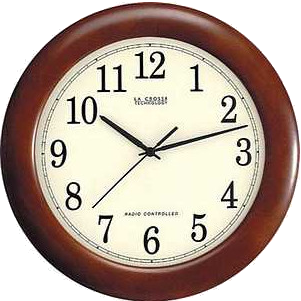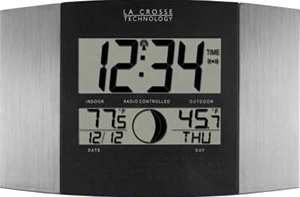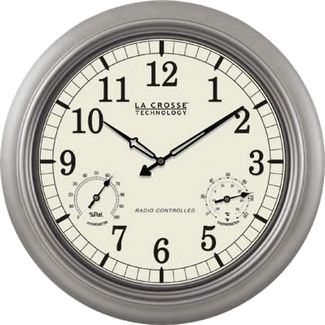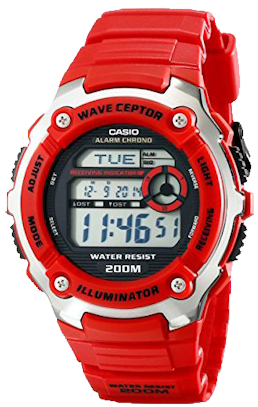What sort of clock might you want to put on the wall of your computer office?
For a travel clock, you want a clock that stays accurate even when you change time zones.
Most of these clocks work from a 50,000 watt radio signal from Fort Collins Colorado. These are accurate to a few tens of milliseconds. It takes the signal about 7 ms to reach me in Victoria. Neither my desk alarm clock or my watch adjust for that. So those two clocks are 7 ms slow, not really noticeable. Others use GPS (Global Positioning System) satellites. Ironically GPS units can display a time up to 1 second different from the calculated time. Some use short-wave signals.
In contrast, the National Research Time Signal broadcast on the CBC (Canadian Broadcasting Corporation) radio network every day at 10AM is 300 ms slow, because it has to be relayed from the NRC (National Research Council) to the network of radio stations and they do not correct for it.
With NTP (Network Time Protocol), asymmetric routes and network congestion can cause errors of 100 ms or
more. It is usually accurate to within 10s of milliseconds, and reach 1 ms accuracy under ideal conditions. If you have a highly accurate Wave Ceptor watch, you might use
it to see how accurate your computer’s NTP clock is. Experiment with different NTP servers until you get
the best accuracy.
There are wall clocks and travel clocks that keep accurate time by synching with a radio signal from the US government NIST (National Institute of Standards and Technology) WWVB radio signal broadcast from Fort Collins, Colorado. This is how high tech wall clocks and wrist watches maintain perfect time and automatically flip back and forth to and from daylight savings. The time signal optimistically presumes all time zones change to DST (Daylight Saving Time) and back in sync. Colorado broadcasts the current time of day and date once a minute, on the minute. Depending on reception it can some clocks up to 72 hours to fully synchronise. I suspect the reason is reception depends on the weather. In 72 hours, you might get at least a few minutes of the optimum weather to get the clock synced. You could speed the process up by taking the clock with you to work or shopping, since likely somewhere on your trip you will get good reception. If you have completely dead reception, they won’t stay in perfect sync unless you repeat the trip periodically.
Because of anomalies such as the fact Illinois ignores DST, the clocks are not always 100% automatic. You have to tell them the time zone and sometimes you must tell them the approximate time. Here is a typical fudge to deal with the fact Illinois ignores DST.
The signal from Colorado includes a bit to say whether DST is currently in effect. The Colorado signal does not contain information about DST for different geographical regions that don’t follow the US federal pattern. This means clocks can handle the national days of switchover being changed but cannot automatically handle regions differing from the national standard.
The clocks work all through the USA and southern Canada, though you need good radio reception. You might want to borrow a clock to test the reception in the room you plan to keep it. You might get great reception on the Colorado side of your building outside, but hopeless reception inside.
Manufacturers call them analog atomic clocks and digital atomic clocks, though there is nothing radioactive in them. They are merely radio-synchronised from a government atomic clock.
When I was a child a read a story about a man who devised a scheme to keep all the world’s clocks in sync. People thought him mad. Today you have to be mad to put up with an inaccurate clock or one that keeps forgetting its time every time it loses AC (Alternating Current) power or its batteries run down.
These clocks are now barely more expensive than ordinary ones. Here are some web stores that have extensive stock:
 WeatherBuffs.com atomic analog, digital, mantel clocks and watches
WeatherBuffs.com atomic analog, digital, mantel clocks and watches| Wall Clocks | |||
|---|---|---|---|
| Model | Cost
|
Appearance | Notes |
| Lacrosse Atomic Analog Wood Wall Clock |
 |
La Crosse WT-3122A Wood. Keeps accurate time by monitoring a radio signal from a US government atomic
clock in Colorado. 12 hour analogy display. No temperature display.
31¾ cm (12½ in) diameter. | |
| Lacrosse Atomic Digital Wall Clock |
 |
La Crosse WS-8117U-IT-AL Weather Station Wall Clock. Keeps accurate time by monitoring a radio signal
from a US government atomic clock in Colorado. It also displays temperature inside and out using an
included remote sensor. 12 or 24 hour digital display. It also computes the phase of the moon.
20.32 × 30.99 cm (8 × 12.20 in) | |
| Lacrosse Atomic Plastic Analog Wall Clock |
 |
La Crosse WT-3181PL. Plastic. Keeps accurate time by monitoring a radio signal from a US government
atomic clock in Colorado. 12 hour analogy display. Relative humidity and internal temperature in
Fahrenheit.
45.72 cm (1½ ft) diameter. | |
 |
recommend electronic⇒Casio Men’s WV-200A-4AVCF Wave Ceptor Red Watch | |||||||||||||||||||||||||||||||||||||||||||||
| asin | B00OBBSUZG | |||||||||||||||||||||||||||||||||||||||||||||
|---|---|---|---|---|---|---|---|---|---|---|---|---|---|---|---|---|---|---|---|---|---|---|---|---|---|---|---|---|---|---|---|---|---|---|---|---|---|---|---|---|---|---|---|---|---|---|
Atomic resync, red, 29 time zones, 200 meter depth. module 3140. The eye in the upper right indicates how strong the resync signal is. The colour is more muted than in the illustration. This is what I use myself. manual. Make sure you download and back up a copy of the manual. You will not be able to operate the watch without it. The four button are refered to as:
| ||||||||||||||||||||||||||||||||||||||||||||||
| ||||||||||||||||||||||||||||||||||||||||||||||
| Greyed out stores probably do not have the item in stock | ||||||||||||||||||||||||||||||||||||||||||||||
There are also radio-synced and GPS synced clock is the form of a board you put in your PC to give your PC a super-accurate timesource. You might use it as the timesource for a network of corporate computers.
Radio-synced clocks have a number of problems:
Here are some ways to deal with those problems:
The problem with this scheme is the radio signal is not powerful enough to penetrate apartment buildings. Your clock may or may not get sufficiently good reception. I suggest that WiFi routers start broadcasting a time signal, perhaps identical to the Fort Collins signal, or perhaps more accurate and simplified. This could be used by all appliances and clocks to automatically track local DST time. The master signal could come from the cable provider.
Most these time signal schemes were in invented cira 1960. The creators did not realise the importance of a common global standard so someone with a radio-synced watch could travel the globe freely. GPS is very accurate and provides very wide coverage. It is only a matter of time until a GPS time-synching chip will be cheap enough for wall-clock, watches, PC clocks etc. So I suspect the antique radio-based schemes will gradually fall away.
This page is posted |
http://mindprod.com/bgloss/radiosyncedclock.html | |
Optional Replicator mirror
|
J:\mindprod\bgloss\radiosyncedclock.html | |
 |
Please read the feedback from other visitors,
or send your own feedback about the site. Contact Roedy. Please feel free to link to this page without explicit permission. | |
| Canadian
Mind
Products
IP:[65.110.21.43] Your face IP:[216.73.216.186] |
| |
| Feedback |
You are visitor number | |